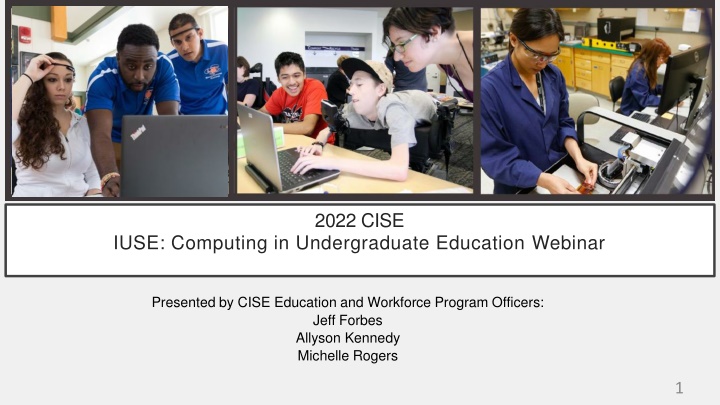
Enhancing Computing Education for Underrepresented Groups
This webinar discusses strategies to increase diversity in computing education, focusing on underrepresented groups such as women, minorities, and individuals with disabilities. The program aims to re-envision teaching methods and support pathways for undergraduate students from underserved backgrounds. Proposals must address broadening participation and can target transformation, pathways, and mobilization initiatives with specific funding categories.
Download Presentation

Please find below an Image/Link to download the presentation.
The content on the website is provided AS IS for your information and personal use only. It may not be sold, licensed, or shared on other websites without obtaining consent from the author. If you encounter any issues during the download, it is possible that the publisher has removed the file from their server.
You are allowed to download the files provided on this website for personal or commercial use, subject to the condition that they are used lawfully. All files are the property of their respective owners.
The content on the website is provided AS IS for your information and personal use only. It may not be sold, licensed, or shared on other websites without obtaining consent from the author.
E N D
Presentation Transcript
2022 CISE IUSE: Computing in Undergraduate Education Webinar Presented by CISE Education and Workforce Program Officers: Jeff Forbes Allyson Kennedy Michelle Rogers 1
MOTIVATION: TO INCREASE NUMBER AND DIVERSITY OF DOMESTIC STUDENTS RECEIVING POST-SECONDARY DEGREES IN COMPUTING Groups who are underrepresentation in CISE: Women Blacks andAfricanAmericans Hispanics American IndiansandAlaska Natives Native Hawaiians and Pacific Islanders Persons with disabilities 2
MOTIVATION: TO INCREASE NUMBER AND DIVERSITY OF DOMESTIC STUDENTS RECEIVING POST-SECONDARY DEGREES IN COMPUTING Percent of CISE majors 12% Hispanic 50% 10% 40% 8% 30% Women 6% Black,non-Hispanic 20% 4% 10% 2% American Indian/AlaskaNative 0% 1970 1980 1990 2000 2010 2015 1985 1990 1995 2000 2005 2010 2015 2020 3
OVERALL GOAL OF THE CUE PROGRAM Re-envision how to teach computing effectively in a scalable manner focusing on those undergraduate students from groups underserved by traditional computing courses and careers 4
CUE Proposal Tracks Transformation Addressing key challenges in undergraduate education (CS+X, updating courses, holistic degree support, inclusive online teaching) Pathways Effective pathways involving 2-year colleges (entry points, transitions) Mobilize Developing a national vision through convening the CISE community 5
ALL CUE PROPOSALS SHOULD ADDRESS BROADENING PARTICIPATION All proposals must explicitly address broadening participation with respect to the two Additional Solicitation Specific Review Criteria: Does the proposal identify the characteristics and needs of the identified underrepresented or underserved groups to be served? Does the proposal include specific plans or strategies for addressing or accommodating the particular needs of participants of the identified underrepresented or underserved groups? 6
OVERVIEW OF FUNDING CATEGORIES Max amount Duration Transformation $2M Up to 5 years Pathways $2M Up to 5 years Mobilize $1M Up to 18 months 7
CUE Transformation Proposals address key challenges in undergrad education 1. 2. 3. Intersection of computing and other disciplines Undergraduate computing courses for 2025 Holistic support toward computing degrees and certifications Effective, inclusive, and equitable online teaching for computing 4. 9
CUE Transformation Expectations Make a substantial regional or national impact on some aspect of computing pathways Innovative ideas in computing education new approaches and action produce fundamental, structural change go outside of or beyond existing norms and principles 10
PATHWAYS 11
CUE Pathways Proposals support and explore effective pathways to computing degrees and careers involving two-year colleges 1. 2. Entry points into two-year colleges The two-year college to four-year college transition **Encourage synergistic partnerships with industry 12
Who can apply? Institutions of Higher Education, Non-profit, non-academic organizations, For-profit organizations, Transformation and Pathways proposals must be comprised of a multi-institutional partnership, with a lead IHE and at least two other IHEs or other organizations. Pathways proposals must include a two-year college as part of the partnership. 13
KEY COMPONENTS OF CUE PROPOSALS Knowledge Base Work is grounded in relevant literature and prior work Evaluation Plan Independent evaluator Description of expertise and relation to project goals/objectives Reporting and use of results 14
KEY COMPONENTS OF CUE PROPOSALS Relevant Research Questions Aligned with research plan, project activities, and expected outcomes Answerable through data generated by activities Dissemination Plan Identify appropriate channels of dissemination Must use Creative Commons licensing for new materials 15
KEY COMPONENTS OF CUE PROPOSALS Sustainability Consider sustainability of activities after funding Design of hardware/software 16
Collaboration Plan Must include: Description of partnership, relevant characteristics of members, and specific roles Initial statement of common goals and examples of possible common metrics Plans for communication and convenings of members Descriptions of any management and administrative structures Methods that will be used in assessing/evaluating the success of the collaboration Specific references to the budget line items that support collaboration and coordination mechanisms 17
MOBILIZE 18
CUE Mobilize proposals will develop a shared national vision around innovation and inclusion in undergraduate computing education 1. 2. 3. Curricular supports in key areas Transformation across institutions Development of a common, scalable educational infrastructure 19
IMPORTANT INFO Full CUE Solicitation (NSF 22-588): https://www.nsf.gov/pubs/2022/nsf22588/nsf22588.htm Proposals due: September 19, 2022: Contact cognizant program officers or email questions to: iuse-cue@nsf.gov 20
QUESTIONS 21
